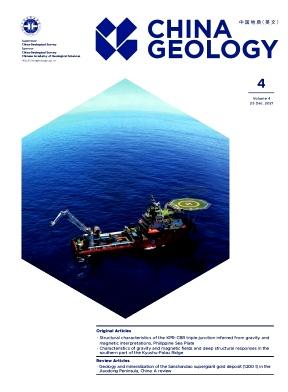Lithofacies palaeogeography, depositional model and shale gas potential evaluation in the O3-S1 Wufeng-Longmaxi Formation in the Sichuan Basin, China
IF 4.7
3区 地球科学
Q1 GEOSCIENCES, MULTIDISCIPLINARY
引用次数: 0
Abstract
The black shales of Wufeng and Longmaxi Formation (Late Ordovician-Early Silurian period) in Sichuan Basin are the main strata for marine shale gas exploration, which have a yearly shale gas production of 228×108 m3 and cumulative shale gas production of 919×108 m3. According to the lithological and biological features, filling sequences, sedimentary structures and lab analysis, the authors divided the Wufeng /Guanyinqiao and Longmaxi Formations into shore, tidal flat, shoal, shallow water shelf and deep water shelf facies, and confirmed that a shallow water deposition between the two sets of shales. Although both Formations contain similar shales, their formation mechanisms differ. During the deposition of Wufeng shale, influenced by the Caledonian Movement, the Central Sichuan and Guizhou Uplifts led to the transformation of the Sichuan Basin into a back-bulge basin. Coinstantaneous volcanic activity provided significant nutrients, contributing to the deposition of Wufeng Formation black shales. In contrast, during the deposition of Longmaxi shale, collisions caused basement subsidence, melting glaciers raised sea levels, and renewed volcanic activity provided additional nutrients, leading to Longmaxi Formation black shale accumulation. Considering the basic sedimentary geology and shale gas characteristics, areas such as Suijiang-Leibo-Daguan, Luzhou-Zigong, Weirong-Yongchuan, and Nanchuan-Dingshan are identified as key prospects for future shale gas exploration in the Wufeng-Longmaxi Formations.
四川盆地五峰组O3-S1岩相古地理、沉积模式及页岩气潜力评价
四川盆地五峰组和龙马溪组(晚奥陶世—早志留世)黑色页岩是海相页岩气勘探的主要层系,年页岩气产量228×108 m3,累计页岩气产量919×108 m3。根据岩性、生物特征、充填序列、沉积构造及实验室分析,将五峰组/观音桥组和龙马溪组划分为海岸相、潮滩相、滩相、浅水陆棚相和深水陆棚相,并确定两组页岩之间存在浅水沉积。虽然这两个组含有相似的页岩,但它们的形成机制不同。五峰页岩沉积时期,受加里东运动影响,川中和贵州隆升使四川盆地转变为后隆起盆地。同期火山活动为五峰组黑色页岩的沉积提供了重要的营养物质。而在龙马溪组页岩沉积过程中,碰撞导致基底沉降、冰川融化导致海平面上升、火山活动的更新提供了额外的营养物质,导致龙马溪组黑色页岩聚集。结合基本沉积地质和页岩气特征,确定了随江—雷波—大关、泸州—自贡、渭荣—永川、南川—顶山等地区为五峰组—龙马溪组页岩气勘探重点区。
本文章由计算机程序翻译,如有差异,请以英文原文为准。
求助全文
约1分钟内获得全文
求助全文

 求助内容:
求助内容: 应助结果提醒方式:
应助结果提醒方式:


